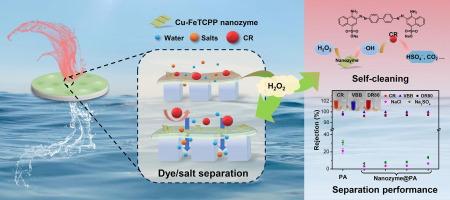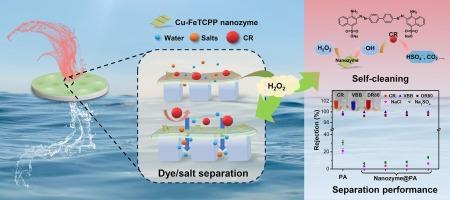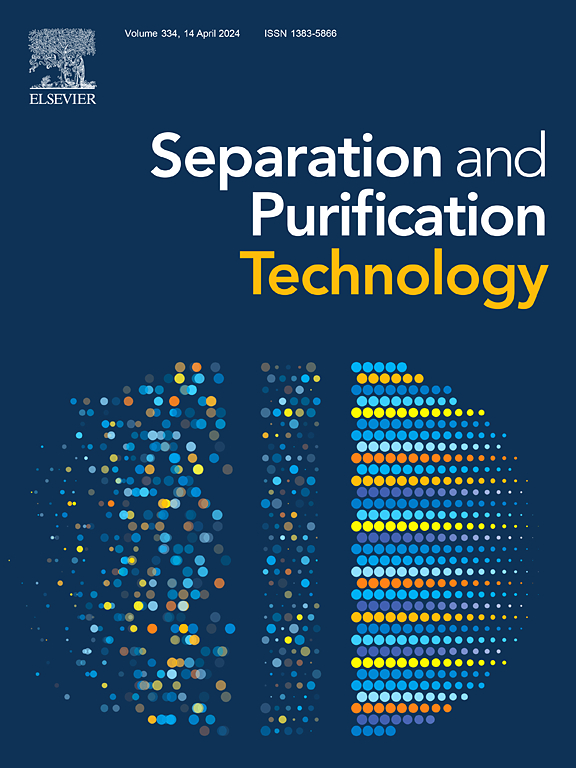Two-dimensional Cu-FeTCPP nanozyme incorporated loose nanofiltration membrane with self-cleaning property for dye/salt separation
IF 8.1
1区 工程技术
Q1 ENGINEERING, CHEMICAL
引用次数: 0
Abstract
Wastewater discharged from the textile industry contains large amounts of dyes and salts, causing serious pollution to the environment. Loose nanofiltration (LNF) membranes offer a promising solution for dye/salt separation. However, membrane fouling is a critical issue affecting the membrane performance. Here, polyether amine (PEA) is used as the aqueous monomer for interfacial polymerization to prepare a polyamide (PA) LNF membrane, and peroxidase-like Cu-FeTCPP nanosheets are embedded into the PA layer to develop the Nanozyme@PA membrane. The nanozyme-incorporated membrane has a thinner and enhanced porous active layer than PA membrane, resulting in higher water permeance (maximum of 80.7 L·m−2·h−2·bar−1), notable rejection of dyes (CR, >99.2 %) but low rejection of inorganic ions (NaCl, <6.4 %). The optimum dye/salt separation factor of Nanozyme@PA reaches 218.7. The loaded nanozyme can catalyze the degradation of dyes adsorbed on the membrane surface in the presence of hydrogen peroxide within 10 min, without the need for special operation, enabling the recovery of water permeance. This nanozyme functionalized LNF membrane with good permeability, selectivity and self-cleaning offers an efficient approach to dye wastewater treatment as well as an insight for membrane fabrication assisted by two-dimensional nanozyme.


具有自清洁特性的二维 Cu-FeTCPP 纳米酶结合松散纳滤膜用于染料/盐分离
纺织业排放的废水中含有大量染料和盐分,对环境造成严重污染。松散纳滤膜(LNF)为染料/盐分离提供了一种前景广阔的解决方案。然而,膜结垢是影响膜性能的一个关键问题。在此,使用聚醚胺(PEA)作为界面聚合的水性单体制备聚酰胺(PA)LNF 膜,并将过氧化物酶类 Cu-FeTCPP 纳米片嵌入 PA 层,开发出 Nanozyme@PA 膜。与 PA 膜相比,加入纳米酶的膜具有更薄和更多孔的活性层,因此透水性更高(最大值为 80.7 L-m-2-h-2-bar-1),对染料(CR,99.2%)的抑制效果显著,但对无机离子(NaCl,6.4%)的抑制效果较低。Nanozyme@PA 的最佳染料/盐分离因子达到 218.7。在过氧化氢存在的情况下,负载的纳米酶可在 10 分钟内催化降解吸附在膜表面的染料,无需特殊操作,即可恢复透水性。这种纳米酶功能化的 LNF 膜具有良好的渗透性、选择性和自洁性,为染料废水处理提供了一种有效的方法,也为二维纳米酶辅助膜的制造提供了启示。
本文章由计算机程序翻译,如有差异,请以英文原文为准。
求助全文
约1分钟内获得全文
求助全文
来源期刊

Separation and Purification Technology
工程技术-工程:化工
CiteScore
14.00
自引率
12.80%
发文量
2347
审稿时长
43 days
期刊介绍:
Separation and Purification Technology is a premier journal committed to sharing innovative methods for separation and purification in chemical and environmental engineering, encompassing both homogeneous solutions and heterogeneous mixtures. Our scope includes the separation and/or purification of liquids, vapors, and gases, as well as carbon capture and separation techniques. However, it's important to note that methods solely intended for analytical purposes are not within the scope of the journal. Additionally, disciplines such as soil science, polymer science, and metallurgy fall outside the purview of Separation and Purification Technology. Join us in advancing the field of separation and purification methods for sustainable solutions in chemical and environmental engineering.
 求助内容:
求助内容: 应助结果提醒方式:
应助结果提醒方式:


